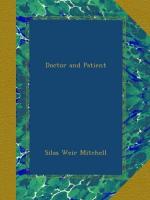As to blunders in the science of poisons I say little. The novelist is a free lance, and chooses his own weapons; but I cannot help remarking that, if recent investigators are to be trusted, one unlucky female, at least, must be still alive, for a novelist relates that she was done to death by the internal taking of a dose of rattlesnake venom. I hope when I am to be poisoned this mode may be employed. She might as well have drunk a glass of milk. That book was a queer one to me after this catastrophe: the woman ought to be dead and could not be.
The difficulty of the modern novelist in giving symptoms and preserving the entire decorum of his pages has amused me a little. Depend upon it, he had best fight shy of these chronic illnesses: they make queer reading to a doctor who knows what sick people are; and above all does this advice apply to death-beds. As a rule, folks get very horrible at such times, and are a long while in dying, with few of their wits about them at the last. But in novels people die marvellously possessed of their faculties; or, if they are shot, always jump into the air exactly as men never do in fact.
Just here, concerning wounds, a question occurs to me: The heroes who have to lose a limb—a common thing in novels since the war—always come back with one arm, and never with a lost leg. Is it more romantic to get rid of one than of the other?—considering also that a one-armed embrace of the weeping waiting lady-love must be so utterly unsatisfactory.
But enough of the patients. Among them I think I like Pendennis the best, and consider little Dombey and Nell the most delightfully absurd. And as to the doctors. Some of them have absolutely had the high promotion to be the heroes of a whole book. Had not one, nay, two, a novel to themselves? There is delightful Dr. Antonio, not enough of a doctor to call down on him my professional wrath. As to Dr. Goodenough, he has been in our family a long while,—on the shelf (God bless him!),—and attended, we remember, our friend Colonel Newcome in that death-bed matchless in art since Falstaff babbled life away. Yet, after all, he is not a doctor so much as a man charmingly drawn.




